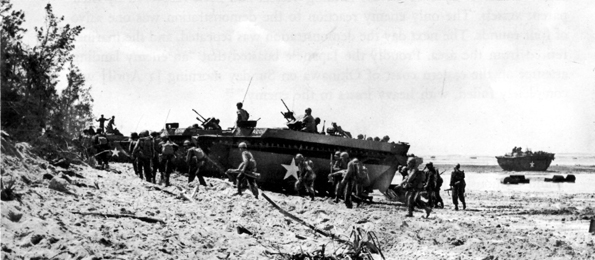On Okinawa, Marines suffer heavy casualties and are unable to advance on Kunishi Ridge. The US 1st Division, already short of troops, is attached to the US 2nd Marine Division.
Forces of the US 24th Corps continue operations to eliminate Japanese positions on Mount Yaeju and Mount Yuza.

Landing Vehicle Tracked (LVT) on 01 April 1945
Okinawa Campaign Background –– LVT Attrition
The USMC, at the beginning of the Okinawa campaign, had used previous island assaults as the base line for provisioning spares and supports for it’s landing vehicle tracked (LVT).
It was utterly inadequate in the face of the reality of protracted combat on Okinawa:
At the beginning of the campaign, the 4th and 9th Amphibian Tractor Battalions with a total of 205 LVTs were attached to the 6th Marine Division. Added to those in the 1st and 8th Battalions attached to the 1st Marine Division, the total number of LVTs available to IIIAC was 421. IIIAC AR, chap VII, p. 101. The resupply of spare parts for LVTs was totally inadequate, especially in the case of such vitally needed basic items as tracks, track suspension system parts, front drive assemblies, and transmission parts. The lack of all of these deadlined a good many LVTs and severely limited the amount of support they could have provided during the drive to the south and in the Oroku landing. At the end of the campaign, 75 LVTs had been completely destroyed as a result of enemy action, or, having been badly damaged, they were cannibalized for spare parts. Of the 346 vehicles remaining, 200 were deadlined for lack of spare parts. Ibid., p. 102.
There were 421 LVT-3 and LVT-4 on 1 April 1945. By the end of the campaign only 146 of that 421 were operational. A number a hair under 35% of the original starting force.
The logistical implications of those numbers for Operation Olympic in November/December 1945 were daunting.
Which reminds me that in the Pacific war; Okinawa, Iwo Jima and perhaps, Wake Island received the most publicity, but few know that the largest invasion in the history of the USA with the most casualties was (no, not D-Day) The Phillipines -Luzon, Leyte etc.
How many LVTs did they think they’d need for Olympic? And how many did they think would be destroyed? Was there a ramp-up in factory production for them? How much lead time was required?
You may be about to tell us this in your next post!
Was Olympic even do-able?
Lex,
Multiple 421 by three to get your Operation Olympic number of LVT amphibious tractor numbers.
Olympic was going to have nine divisions on three beaches. The first four assault waves for each beach — based on the Operation Iceberg template — would be the infantry battalions of two infantry regiments from each from the lead two assault divisions.
These first four assaults wave would have two LVT tractor battalions, a LVT Amphtank battalion and two M4 Sherman T-6 companies launched from LST, LSM, LSV,and LSD amphibious transports.
The next 8-to-10 follow up waves would be on LCVP ( troops), LCM (Tanks, vehicles, artillery), LCT (Same as LCM, just 3 X as much) and possibly LSM. They would carry the divisional artillery, the third infantry regiment (less the divisional reserve) ammunition and supplies.
Additional LVT battalions of the tractor and tank types would be available for the pre and post X-day landings to the tune of four to six LVT tractor and two to three LVT tank.